|
The History of the Sparrows Herne Turnpike |
|
||||||
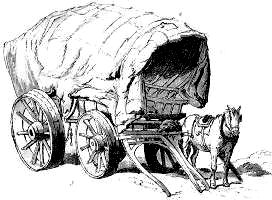 The
valleys of the River Gade and the River Bulbourne form a natural route through
the Chiltern Hills for travellers from the area of London towards the Midlands.
This was the route taken by a significant Roman Road, later called Akeman
Street.
The
valleys of the River Gade and the River Bulbourne form a natural route through
the Chiltern Hills for travellers from the area of London towards the Midlands.
This was the route taken by a significant Roman Road, later called Akeman
Street.
The road remained a major route over the centuries, and people would have travelled by foot and horseback, with goods being carried by pack horse and by the medieval times the occasional heavy and clumsy carts with broad wheels. As London grew in size traffic increased, including herds of cattle and other livestock, and the place called Cow Roast, between Berkhamstead and Tring, was probably "Cow Rest" - a place where cattle could rest and feed on their journey to the London butchers.
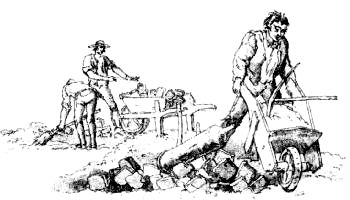 The
problem was that the art of road building and maintenance became lost when the
Romans left the country and after 1000 years of neglect the old roads were in a
very sorry state. In 1555 a law was passed requiring every parish to take
responsibility for the roads which crossed it. This was an unwelcome job,
carried out by people with no great skills in road building, and in some places,
if a road became rutted the "repair" was to plough it up and roll it flat.
The
problem was that the art of road building and maintenance became lost when the
Romans left the country and after 1000 years of neglect the old roads were in a
very sorry state. In 1555 a law was passed requiring every parish to take
responsibility for the roads which crossed it. This was an unwelcome job,
carried out by people with no great skills in road building, and in some places,
if a road became rutted the "repair" was to plough it up and roll it flat.
By the 18th century the volume of traffic and the poor state of the road meant that something urgently needed to be done. The solution was the turnpike road. A number of local landowners would agree to repair and maintain a stretch of road, toll gates would be erected, and the tolls used to maintain the road - and provide a return for the investors. In order for this to be done it was necessary for there to be an Act of Parliament, and so the establishment of the turnpikes is well documented.
One of the early roads to become a turnpike was the road from London to Watford and in 1762 an Act was passed to turn the continuation of the road from Bushey to Aylesbury into a turnpike. This was called the Sparrows Herne Turnpike.
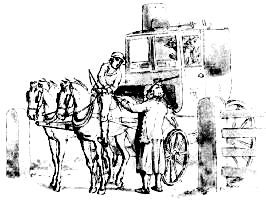
The original toll gates were at:
Watford Gate, at the bottom of Chalk Hill
Ridge Lane Gate, on the North side of Watford
New Ground Gate, to the south of Tring
Veeches Farm Gate to the west of Aston Clinton
Brick toll houses for these gates were built at a cost of around £25 each. Toll keepers were appointed and paid 10s 6d a week for which they had to man the gate day and night and from which money they had to pay for the oil for the night time illumination of the gates with lamps.
In 1827 the northernmost gate was moved to Aylesbury, and in 1869 another gate was established at the top of Tring Hill.
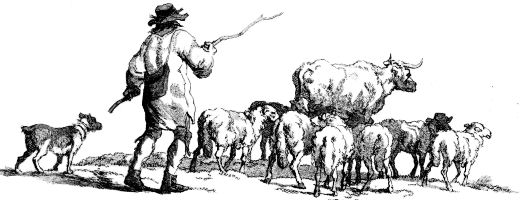
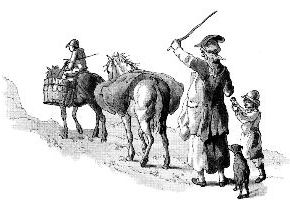 The
Act (which was renewed at intervals) laid down the maximum toll rates and in
1762 they were:
The
Act (which was renewed at intervals) laid down the maximum toll rates and in
1762 they were:
While the state of the road undoubtedly improved, so did the traffic, which meant more wear and tear.
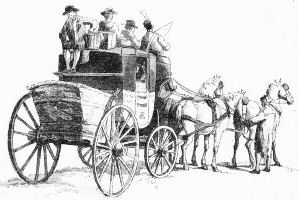 In the early 19th century, Thomas Telford and John McAdam
introduced skilled road design, and with the improved surfaces revolutionised
the speed and comfort of travel. The heydays of the stage coach had arrived. The
hostelries in the towns and villages along the route had always catered for the
passing trade, and must have been delighted with the increased business the
turnpike had brought.
In the early 19th century, Thomas Telford and John McAdam
introduced skilled road design, and with the improved surfaces revolutionised
the speed and comfort of travel. The heydays of the stage coach had arrived. The
hostelries in the towns and villages along the route had always catered for the
passing trade, and must have been delighted with the increased business the
turnpike had brought.
By about 1828 (Pigot's Directory) there were two regular long distance stage coaches stopping in Tring daily. The Young Pilot picked up passengers at the Rose and Crown, Tring, at seven in the morning - going to the Kings Arms, Holborn Bridge, London. In the other direction it picked up passengers at 12 noon for Aylesbury and Bicester. The stage coach calling at The Bell, Tring, was The Good Intent which picked up passengers at seven in the morning - going to the Old George, Snowhill, London. On its return journey in went to Aylesbury, Bicester and Kidderminster, passing through Tring at ten in the morning. Another more local coach did the round trip from Aylesbury to London and back in the day, returning to Tring at six in the evening. In addition there were daily mail coaches to London, Manchester and St Albans. Goods could be sent to London by Barthom's wagon which ran from the Bell on Tuesday and Friday or by Hearne's wagons, which called in Tring on its twice weekly trip between Aylesbury and London,
There were other coaching inns along the Sparrows Herne - the Kings Arms at Berkhamsted, the Rose & Crown at Kings Langley and Rose & Crown, The George and the Essex Arms in Watford - and there were other long distance coaches, for example to Birmingham, which apparently passed through Tring and Kings Langley without stopping to pick up passengers, although they may have stopped to change horses and give their passengers a comfort break..
This boom in trade did not last long as in 1837 the railway opened from London to Birmingham, providing a much faster and cheaper journey and the days of the stage coach were over. They had vanished entirely from the Sparrows Herne by 1850 (Post Office Directory) and had been replaced by, for example, a horse-drawn omnibus between the Rose & Crown at Tring and Tring Station to meet the trains.
The Trust finally ended in 1872 when the last tolls were collected, with responsibility for maintenance transferring to the local town councils. The coming of the car led to increase traffic and in the 1930s the main road between Watford and Aylesbury was designated the A41. Watford was the first town to be by-passed before the Second World War, with the M1 taking more traffic from the 1960s, and Tring being bypassed shortly afterwards. Kings Langley, Apsley and Berkhamsted were bypassed in the 1990s, followed by the Aston Clinton bypass. The only length of the old Roman Road/Sparrows Hearne still in use use as a trunk road in Hertfordshire is a short length near Hunton Bridge, which has been upgraded to dual carriageway.
----------------
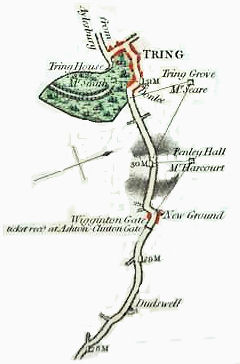 Extract from John Cary's Survey of the High Roads from London showing the New Ground Gate. (1790) |
There are significant original records relating to the Sparrows Herne Trust in records offices (search A2A for details) and I have located (but not seen) the following publications:
Humphreys, A. L. 'Records of Turnpike Trusts : Sparrows Herne'. in Notes and Queries, 180 (1941), 211-13.
Littlefair, K. The Life of the Sparrows Herne Turnpike Trust 1762-1873 (1968 Dissertation, University of Exeter)
There is also further useful information in the following books:
The Toll Roads of Buckimghamshire - A detailed account of the history of the turnpike - and a good introduction to toll roads and turnpike trusts.
Berkhamsted: An Illustrated History - includes copy of 18th century map of Sparrows Herrne
A Hertfordshire Valley - includes information on the highway robber, James Snook. who robbed John Stevens, who was carrying the mail between Tring and Hemel Hempstead.
Royalty to Commoners: Four Hundred Years of the Box Moor Trust - with information on the road crossing Boxmoor
Old Prints from Microcosm, by W. H. Pyne, 1808 - republished in parts by Luton Museum 1970, 1972, 1974, 1977
Page created February 2009 - additional information of carriers and mail coaches added May 2009.